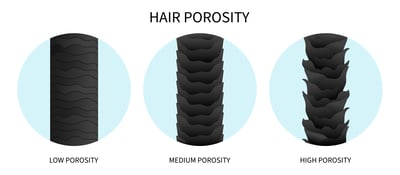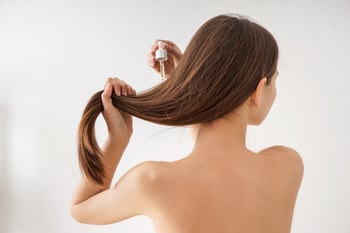S16 Blog

What is Hair Porosity and How to Tailor Your Tress Care Routine
Can you relate to this scenario? On a humid day (not a very common occurrence in our region!), even if you leave your house with shiny, smooth hair, you can expect frustrating frizz to rear its head within a few hours. If this sounds familiar, you probably have high-porosity hair.
Or maybe this sounds more like your experience: It seems to take forever to dry your hair, and products often build up on your mane, weighing it down. If so, you probably have low-porosity hair.
Now you may have simply been looking for tips on taming your hair instead of a vocabulary lesson. Porosity is probably a word you’ve never heard before. But a little bit of knowledge about why your hair behaves the way that it does can go a long way. Read on to learn more about hair porosity, how to figure out your hair’s porosity, and how best to care for it.
What Is Hair Porosity?
Now first, what is hair porosity, exactly? Hair porosity is how well your hair’s outermost layer (cuticle) absorbs and maintains moisture and products. To put it more simply, it’s how your hair reacts to moisture from water or the ingredients in your favorite hair products. For your hair to stay healthy, your products need to be able to break through the cuticle and reach the innermost part of your hair. There are three types of hair porosity:

- High porosity - Cuticles that are farther apart
- Medium porosity - Cuticles that are less tightly bound
- Low porosity - Cuticles that are closer together
Unless you own a microscope, how can you know how far apart the cuticles are in your hair? Just like most things, there’s a trick, and probably a YouTube video, to find out. The best way to determine your hair’s porosity is with the water glass test. Cut a couple of clean, product-free hair pieces from your head, place them in a glass of water, and leave them there for a few minutes. If your hair sinks to the bottom, it’s highly porous. If it floats at the top, it’s low porosity; if it hovers in the middle of the water, it’s medium. Hair porosity is mainly determined by genetics, but it can also be affected by chemical processing, UV exposure, and heat damage.
Which Level of Porosity is Better?
If I have low porosity, should I be envious of those with high porosity? Which type is better? Simply put, none of the three types of hair porosity is better than the others.
While high porosity hair absorbs moisture quickly and doesn’t take as long to dry, it also doesn’t retain moisture as easily as other types. The result can be frizz, tangles, dryness, and breakage.
Low porosity takes a long time to dry and doesn’t easily absorb products, but it is more resilient.
Medium porosity hair is generally the easiest type to maintain. It absorbs and retains moisture easily. However, it can also be prone to frizz and dryness, although not as much as high porosity hair. All in all, each type of porosity requires specific treatment and care.
How to Keep Your High Porosity Hair Shiny and Resilient:
 1. Choose heavier, moisture-rich products - Hair care products containing ingredients such as oils or butter and protein-rich shampoos help fight the frizz.
1. Choose heavier, moisture-rich products - Hair care products containing ingredients such as oils or butter and protein-rich shampoos help fight the frizz.- 2. Use lukewarm water to wash your hair - Hot water can raise the cuticles more which causes damage, whereas cold water won’t adequately rinse out products.
- 3. Get regular trims - High porosity hair is prone to split ends, so regular trims will keep it healthy.
- 4. Avoid tight hairstyles - Ponytails or other styles that pull at your hair can cause additional breakage.
How to Maintain Healthy, Bouncy, Low Porosity Hair:
- 1. Use lightweight products - Lighter-weight oils can penetrate the cuticle. Look for products with almond and argan oil.
- 2. Use a residue-free shampoo - Because shampoo tends to sit on your hair instead of being absorbed, a residue-free shampoo will ensure it doesn’t accumulate and weigh down your tresses.
- 3. Don’t use shea or cocoa butter - These products repel water and can further prevent moisture absorption.
- 4. Steam your hair - This helps to lift hair cuticles to allow better water penetration.
Make the Most of Your Medium Porosity Hair:
- 1. Take care of tangles - Use a detangling spray or leave-in conditioner to comb through it more easily. Then, use a wide tooth comb to remove the tangles.
- 2. Avoid heat and chemicals - Maintain your hair’s resiliency by air drying as much as possible.
- 3. Use a light conditioner - This product will keep your locks soft and supple without leaving an oily film on the strands.
- 4. Avoid heavy silicone products - These include hard-to-remove products such as simethicone, trimethicone, and trimethylsiloxysilicate.
We Are Here to Help
As the largest AVEDA salon and ONLY Oway retailer in Eastern Washington, the team at Studio 16 can help you identify the different characteristics of your hair and scalp and offer the treatments or products to help you get the healthiest locks possible, regardless of your hair type. Our dedicated team are professionals committed to giving you an exceptional experience. Our guests always get a unique experience that goes beyond the individual hair or skin services that we tailor to your needs. Let us help you feel like the best version of yourself.

Leave your thought here
Your email address will not be published. Required fields are marked *